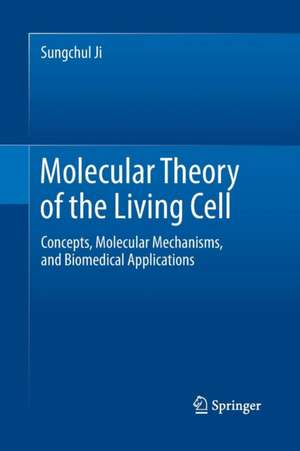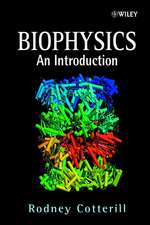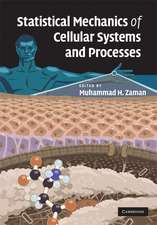Molecular Theory of the Living Cell: Concepts, Molecular Mechanisms, and Biomedical Applications
Autor Sungchul Jien Limba Engleză Paperback – 22 aug 2016
| Toate formatele și edițiile | Preț | Express |
|---|---|---|
| Paperback (1) | 1239.19 lei 6-8 săpt. | |
| Springer – 22 aug 2016 | 1239.19 lei 6-8 săpt. | |
| Hardback (1) | 1243.29 lei 6-8 săpt. | |
| Springer – 4 apr 2012 | 1243.29 lei 6-8 săpt. |
Preț: 1239.19 lei
Preț vechi: 1511.20 lei
-18% Nou
Puncte Express: 1859
Preț estimativ în valută:
237.19€ • 257.73$ • 199.37£
237.19€ • 257.73$ • 199.37£
Carte tipărită la comandă
Livrare economică 21 aprilie-05 mai
Preluare comenzi: 021 569.72.76
Specificații
ISBN-13: 9781493939374
ISBN-10: 1493939378
Pagini: 772
Ilustrații: XXI, 748 p. 237 illus., 129 illus. in color.
Dimensiuni: 155 x 235 x 39 mm
Greutate: 1.06 kg
Ediția:Softcover reprint of the original 1st ed. 2012
Editura: Springer
Colecția Springer
Locul publicării:New York, NY, United States
ISBN-10: 1493939378
Pagini: 772
Ilustrații: XXI, 748 p. 237 illus., 129 illus. in color.
Dimensiuni: 155 x 235 x 39 mm
Greutate: 1.06 kg
Ediția:Softcover reprint of the original 1st ed. 2012
Editura: Springer
Colecția Springer
Locul publicării:New York, NY, United States
Cuprins
Part I Principles, Laws, and Concepts.- Physics.- Chemistry.- Biology.- Engineering.- Linguistics, Semiotics, and Philosophy.- Part II Theories, Molecular Mechanisms, and Models.- Molecular Mechanisms of Enzymic Catalysis.- The Conformon.- Intracellular Dissipative Structures (IDSs).- The Living Cell.- Part III Applications: From Molecules to Mind and Evolution.- Subcellular Systems.- Whole Cells.- Mechanisms of the Origin of Life.- Principles and Mechanisms of Biological Evolution.- Multicellular Systems.- What Is Life?- Why Is the Cell So Complex?- Ribonoscopy and Personalized Medicine.- Ribonoscopy and ‘Theragnostics’.- Application of the Knowledge Uncertainty Principle to Biomedical Sciences.- Conclusions.
Notă biografică
After two years of pre-engineering training at the College of Engineering, Seoul National University in Seoul, Korea, the author obtained a scholarship in 1962 to study at the University of Minnesota, Duluth, receiving a Bachelor’s degree in chemistry and mathematics in 1965. The author received a Ph.D. degree in physical organic chemistry from the State University of New York at Albany in 1970. Between 1970 and 74, he was a postdoctoral fellow and a Research Assistant Professor at the Institute for Enzyme Research at the University of Wisconsin, Madison, studying the molecular mechanisms of oxidative phosphorylation in mitochondria. The concept of the conformon that plays a key role in the theory of the living cell described in the book was first formulated while the author was carrying out bio-theoretical research in Madison. He then spent 2 years at the Johnson Research Foundation at the University of Pennsylvania investigating the space-dependent NADH fluorescence signals from rat liver and brains as a function of metabolic and circulatory perturbations. Based on the results of these experiments, the author was invited to join a research group at the Max Planck Institute for Systems Physiology, Dortmund, West Germany, as a visiting scientist, between 1976 and 1979, returning to the US in 1979 as a Research Associate Professor at the Department of Pharmacology, University of North Carolina School of Medicine, Chapel Hill, NC. The author spent 3 years in Chapel Hill, elucidating the mechanisms of alcohol-induced liver injury using rat models. Since 1982, the author has been teaching and carrying out theoretical and experimental research in the Department of Pharmacology and Toxicology at Rutgers University, Piscataway, NJ, where the author formulated the Bhopalator model of the cell in 1983 and has been developing and applying it to pharmacology and toxicology ever since.
Textul de pe ultima copertă
This book presents a comprehensive molecular theory of the living cell based on over thirty concepts, principles and laws imported from thermodynamics, statistical mechanics, quantum mechanics, chemical kinetics, informatics, computer science, linguistics, semiotics, and philosophy. The author formulates physically, chemically and enzymologically realistic molecular mechanisms to account for the basic living processes such as ligand-receptor interactions, protein folding, single-molecule enzymic catalysis, force-generating mechanisms in molecular motors, signal transduction, regulation of the genome-wide RNA metabolism, morphogenesis, the micro-macro coupling in coordination dynamics, the origin of life, and the mechanisms of biological evolution itself. Possible solutions to basic and practical problems facing contemporary biology and biomedical sciences have been suggested, including pharmacotheragnostics and personalized medicine.
Caracteristici
First book on the molecular theory of the living cell, utilizing the principles, laws and concepts derived from physics, chemistry, computer science, linguistics, semiotics and philosophy The book contains a most complete catalogue of the fundamental molecular mechanisms responsible for molecular processes supporting life The book applies the molecular principles of the living cell to solving not only basic problems encountered in contemporary molecular biology such as the definition of a gene but also practical problems














